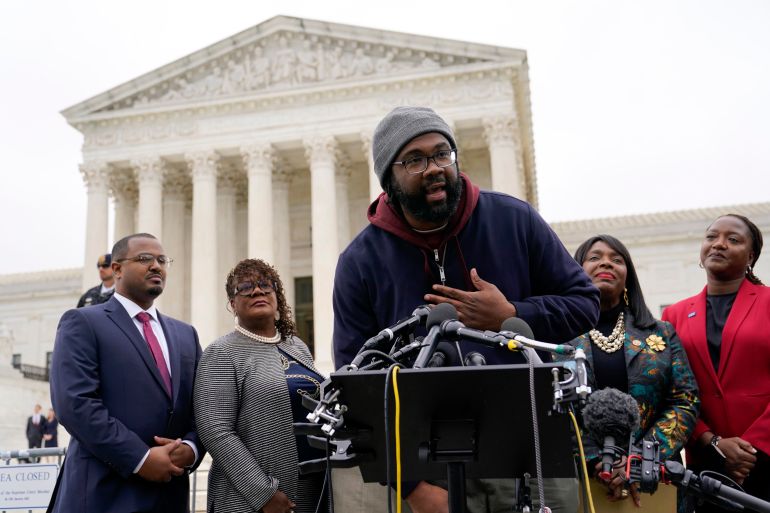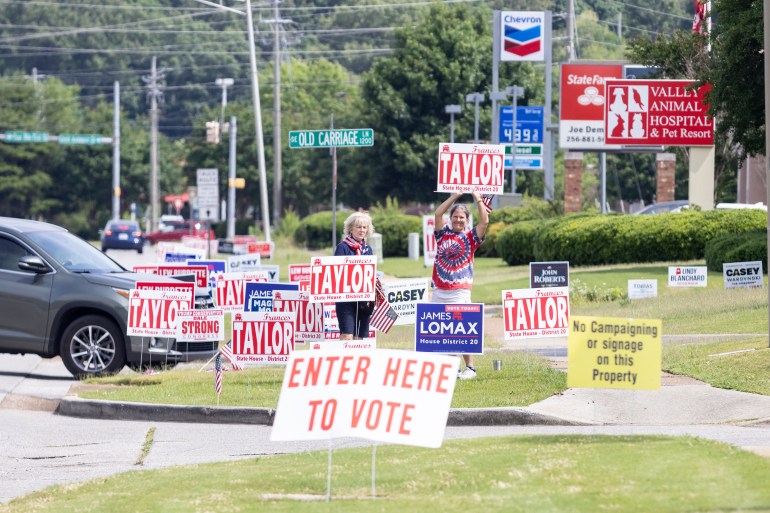US Supreme Court rules in favour of Alabama Black voters
Court ruled that Republican redistricting violated the Voting Rights Act’s provisions against racial discrimination.

The conservative-dominated United States Supreme Court, in a surprise ruling, has sided with Black voters who alleged a Republican-drawn districting map in the state of Alabama was discriminatory.
In a 5-4 ruling, the court said that the congressional map — which had only one majority Black congressional district out of seven, in a state where more than one in four residents is Black — likely violated the landmark civil rights-era Voting Rights Act.
Keep reading
list of 3 itemsUS Supreme Court deals blow to organised labour in new ruling
US Supreme Court agrees to hear case on alleged voting map biases
The case was closely watched due to its potential to further weaken the Voting Rights Act, which was passed in 1965 and sought to prevent Jim Crow-era racial discrimination in US voting. Several Supreme Court rulings in recent years have chipped away at the legislation, most notably a 2013 decision that blocked a provision of the law that required states with a history of discriminatory voting practices to face federal review of new laws and procedures.
On Thursday, the American Civil Liberties Union hailed the latest ruling as a “huge win for Black voters in Alabama”, saying the challenged map had “diluted Black political power”.
Chief Justice John Roberts and Justice Brett Kavanaugh joined with the court’s liberals in the majority decision.
BREAKING: The Supreme Court just ruled that Alabama's 2021-enacted congressional map violated the Voting Rights Act of 1965 because it diluted Black political power.
Alabama must now redraw its congressional map.
— ACLU (@ACLU) June 8, 2023
In lower courts, challengers to Alabama’s map argued that the composition reduced the influence of Black voters by concentrating their voting power in one district while distributing the rest of the Black population at levels too small to form a majority in other districts.
They charged the map violated Section 2 of the Voting Rights Act, a provision aimed at countering measures that result in racial bias in voting, even absent racist intent. The Supreme Court’s ruling said that Alabama’s Black population is indeed large enough and geographically compact enough to warrant a second district being drawn.
The state of Alabama, which appealed the lower court’s ruling, had argued that drawing a second district to give Black voters a better chance at electing their preferred candidates would itself be racially discriminatory.
They argued that a second district would favour them at the expense of other voters, and they called the current map “race neutral”.

During Supreme Court arguments in October, Justice Ketanji Brown Jackson pushed back against the idea that race should not be part of the redistricting equation.
She argued that amendments made to the US Constitution following the Civil War created a legal basis for legislation “designed to make people who had less opportunity and less rights equal to white citizens”.
Partisan politics undergird the redistricting issue, though. US states redraw their congressional districts to reflect changing populations every decade. In most states, that redistricting is done by the party in power at the time, which regularly leads to accusations of map manipulation for partisan gain.
Alabama’s state legislature is dominated by Republicans. Creating a new district with a large — if not majority — Black population could result in the state sending a second Democrat to the US House of Representatives.